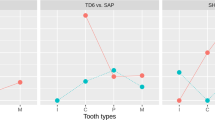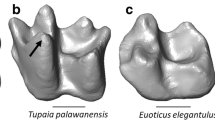Abstract
Based on a roentgenographic analysis, the molar enamel of certain European Miocene dryopithecines is absolutely thick (r=1.03–1.30 mm in thickness); the molar enamel of certain European pliopithecines is thin (r=0.32–0.82 mm thick). The rank order for enamel thickness in extant hominoids (from thickest to thinnest) is confirmed to beHomo, Pongo, Gorilla, Pan, andHylobates. There is a great deal of enamel thickness variability within the great ape sample. Extant analogues suggest that dryopithecines were probably adapted to a frugivorous/gramnivorous dietary regimen, while pliopithecines were probably better suited to folivory.
Similar content being viewed by others
References
Andrews, P., and Martin, L. (1987). Cladistic relationshps of extant and fossil hominoids.J. Hum. Evol. 16: 101–118.
Beynon, A. D., and Wood, B. A. (1984). Preliminary observations on enamel structure and thickness in fossil hominids.J. Dent. Research 63: 505.
Beynon, A. D., and Wood, B. A. (1986). Variations in enamel thickness and structure in East African hominids.Am. J. Phys. Anthrop. 70: 177–193.
Dahlberg, A. A. (1963). Dentition of the American Indian. In Brothwell, D. R. (ed.),Dental Anthropology, Pergamon, Oxford, pp. 149–177.
Gantt, D. G. (1981). Enamel thickness and Neogene hominoid evolution.Am. J. Phys. Anthrop. 54: 222.
Gantt, D. G. (1982). Hominid evolution—a tooth's inside view. In Kurten, B. (ed.),Teeth: Form, Function and Evolution, Columbia University Press, New York, pp. 107–120.
Gantt, D. G. (1983). The enamel of Neogene hominoids: Structural and phyletic implications. In Ciochon, R. L., and Corruccini, R. S. (eds.),New Interpretations of Ape and Human Ancestry, Plenum Press, New York, pp. 249–298.
Gantt, D. G. (1986). Enamel thickness and ultrastructure in hominoids: With reference to form, function, and phylogeny. In Swindler, D. R., and Erwin, J. (eds.),Comparative Primate Biology, Vol. 1. Systematics, Evolution, and Anatomy, Alan R. Liss, New York, pp. 453–475.
Kay, R. (1981). The nut-crackers—a new theory of the adaptations of the Ramapithecinae.Am. J. Phys. Anthrop. 55: 141–151.
Kelley, J., and Pilbeam, D. (1986). The dryopithecines: Taxonomy, comparative anatomy, and phylogeny of Miocene large hominoids. In Swindler, D. R., and Erwin, J. (eds.),Comparative Primate Biology, Vol. 1. Systematics, Evolution, and Anatomy, Alan R. Liss, New York, pp. 361–411.
Martin, L. (1985). Significance of enamel thickness in hominoid evolution.Nature 314: 260–263.
Molnar, S., and Gantt, D, (1977). Functional implications of primate enamel thickness.Am. J. Phys. Anthrop. 46: 447–454.
Nagatoshi, K. (1984).Systematics and Paleoecology of European Tertiary Apes. Ph.D. dissertation, University of Chicago, Chicago.
Nagatoshi, K. (1987). Miocene hominoid environments of Europe and Turkey.Palaeogeog. Palaeoclimatol. Palaeoecol. 61: 145–154.
Pilbeam, D. (1986). Hominoid evolution and hominoid origins.Am. Anthropol. 88: 295–312.
Shellis, P., and Hiiemae, K. (1984). Molar enamel thickness and structure in primates and insectivores in relation to diet.J. Dent. Res. 63: 505.
Simons, E. L., and Pilbeam, D. (1972). Hominoid paleoprimatology. In Tuttle, R. H. (ed.),The Functional and Evolutionary Biology of Primates, Aldine, Chicago, pp. 36–62.
Sperber, G. H. (1985). Comparative primate dental enamel thickness: A radiodontological study. In Tobias, P. V. (ed.),Hominid Evolution: Past, Present and Future, Alan R. Liss, New York, pp. 443–454.
Szalay, F. S., and Delson, E. (1979).Evolutionary History of the Primates, Academic Press, New York.
Taylor, R. M. S. (1978).Variation in Morphology of Teeth, Charles C Thomas, Springfield, Ill.
Author information
Authors and Affiliations
Rights and permissions
About this article
Cite this article
Nagatoshi, K. Molar enamel thickness in European Miocene and extant hominoidea. International Journal of Primatology 11, 283–295 (1990). https://doi.org/10.1007/BF02193001
Received:
Revised:
Issue Date:
DOI: https://doi.org/10.1007/BF02193001




